Face Moulding
Many facial treatments used in early Beauty Culture depended on the belief that the structures of the face were plastic and could be transformed by manual therapies. The most important of these treatments was massage or – for those beauty culturists who thought massage stretched the skin – patting.
See also Massage, Wrinkles and Double Chins and Patters
Massage could be done in isolation, using a massage oil or cream as a lubricant, but salons soon combined it with a range of skin preparations all designed to enhance its effects. These included skin cleansers to prepare the skin, skin tonics and astringents to tighten muscles and flabby tissue, and skin foods to build up muscles and fat.
See also Skin Foods and Skin Tonics, Astringents and Toners
Combining massage or patting with skin preparations in a facial treatment was sometimes described as ‘moulding’ or ‘remoulding’ the contours of the face similar to the way a sculptor would fashion a bust of clay.
Whether it be to form or reform your complexion, mould or remodel your contour, correct a blemish large or small, Helena Rubinstein’s vast fund of experience, Helena Rubinstein’s inexhaustible understanding and skill promise you that your looks shall not be a matter of chance but of your own choosing.
(Helena Rubinstein advertisement, 1925)
Contouration Treatments gently remould and improve your contours. Just as a sculptor shapes his clay, Contouration Treatments reduce where reducing is essential—build up where building will increase beauty!
(Contourè Laboratories advertisement, 1926)
Primrose House
No cosmetic company is more closely associated with face moulding than Primrose House, formed in 1921 by the Lowell Company of Lowell, Massachusetts. The Lowell investors had no experience in the beauty industry so they hired the copywriter Helen Rosen Woodward [1882-1972] to develop the company’s products and practices (Peiss, 1998, p. 117) and Lucille Buhl Bonanno to help with the technical side of the new business. Lucille developed the face moulding apparatus Primrose House used and she was granted a patent for the device in 1923 (US: 1443725).
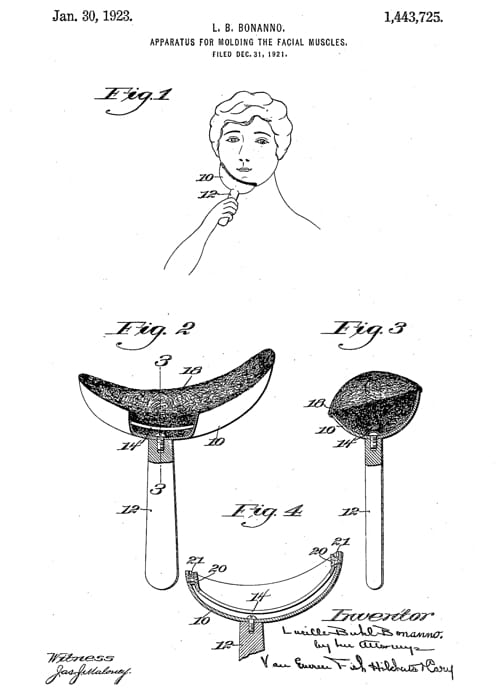
Above: 1923 Patent drawing for an ‘Apparatus for molding the facial muscles’ developed by Lucille Buhl Bonanno assigned to The Lowell Company who owned Primrose House.
Although Lucille invented the Face Molder it is probable that Helen Woodward wrote the advertising copy for it.
The fundamental principles in all our treatment work here at Primrose House is that of molding the underlying muscles of the face and neck into lines of strength and beauty. Primrose House has the distinction of having originated this method known as Face Molding. It is founded upon the knowledge of the physiological structure of the face and neck. The tissues of the skin and the controlling muscles just beneath it share in their own fashion the constant changes and renewals which the whole human organism undergoes.
It is necessary then to first build up these muscles, to make them firm, to renew the circulation before supplying the correct nutrient to the skin. And because the muscles of the face are plastic, they can actually be folded into a condition of youthful health by eliminating the effects and signs of illness and age. Do not confuse Face Molding with massage. Face Molding does not stretch the skin. Face Molding, in a word, consists of a gentle yet definite pressure and relaxation of the fingers following the muscles with an upward motion. It is unquestionably the sanest way to strengthen the muscles and so regain their elasticity.(Primrose House, n.d., pp. 6-7)
Clients could buy the Primrose House Face Molding Treatment Set for use at home. It consisted of the Face Molder, Rose Leaf Cleansing Cream, Skin Freshener, Face Molding Cream and Balsam Astringent.
After the face was cleansed with Rose Leaf Cleansing Cream and lightly sponged with Skin Freshener, Face Molding Cream was smoothed over the face and throat. Using a muscle chart supplied by Primrose House, the face was then moulded with the fingertips generally in an upward and outward direction. To complete the treatment the face and throat were then treated with the Face Molder packed with cotton wool saturated with Balsam Astringent. As the Face Molder was pressed against the skin it produced a tightening sensation, reinforcing the feeling that the muscles of the face had been remoulded and the facial contours corrected. Primrose House also recommended that a chin strap be used for at least half-an-hour every day to further help the neck regain its natural elasticity.
See also: Primrose House
Elizabeth Arden
Although other companies also used the idea of face moulding in the 1920s and 1930s, as far as I know only Elizabeth Arden developed a face moulding device similar to the one made by Primrose House.
The Elizabeth Arden original Face Moulding Treatment consisted of a cleanser (Ardena Cleansing Cream), a toner (Ardena Skin Tonic), and a skin cream (Velva Cream or Orange Skin Food).
Animation enhances the beauty of the most beautiful face—vivacity adds charm to the loveliest features—together their effect is irresistible … but there can be no animation, no vivacity, if muscles have been allowed to become weak and flaccid—if contours have begun to sag—if ugly hollows are developing around the throat. The New Elizabeth Arden Face Moulding Treatment is a practical application of Miss Arden’s famous principle: that it’s never too late, nor too early, to make a start.
(Elizabeth Arden advertisement, 1937)
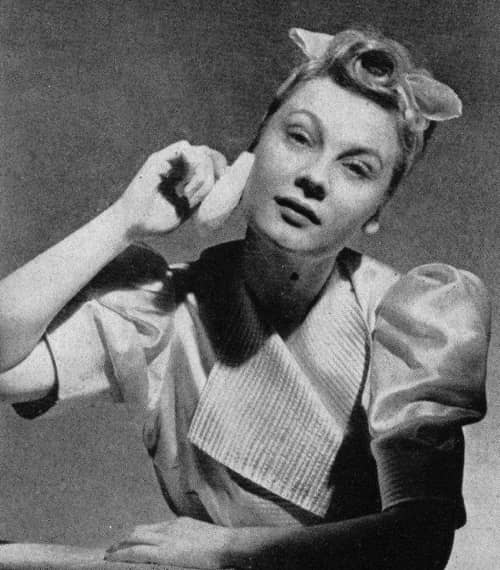
Above: 1939 Woman using an Ardena Face Moulder.
The Ardena Face Moulder, used with Elizabeth Arden Special Astringent Lotion, was added to Arden’s Moulding Home Treatment in 1938. After it was dipped in cold water, squeezed out and then saturated with Special Astringent Lotion, the Ardena Face Moulder was worked all over the face with a ‘rhythmic, kneading action’, working upward and outward across the throat and face, concentrating on those areas where muscle weakness might lead to lines and wrinkles. This contrasts with the Primrose House Face Molder which was simply pressed into the face and neck after the moulding routine was completed.
See also: Elizabeth Arden (1930-1945)
Like Primrose House, Arden also recommended the use of a chin strap but she also included a set of ‘muscle-strengthening’ facial exercises for clients to carry out for good measure.
See also: Facial Gymnastics
More recent developments
Specific face moulding devices like those developed by Primrose House and Elizabeth Arden were soon abandoned. Given that they were little more than applicators for holding pads of astringent there was little reason for someone to buy them. However, concern over weakening facial muscles, drooping skin and wrinkles did not go away.
Although astringents are no longer used to give the face a more youthful look, the idea of improving the contours of the face through massage is still advanced today; only these days – now that cosmetic surgery has become commonplace – it is called a ‘face-lift massage’.
Updated: 28th February 2019
Sources
Peiss, K. (1998). Hope in a jar: The making of America’s beauty culture. New York: Henry Holt and Company.
Primrose House. (n.d.). Primrose House [Booklet]. New York: Author.
Woodward, H. (1926). Through many windows. New York: Harper & Brothers.
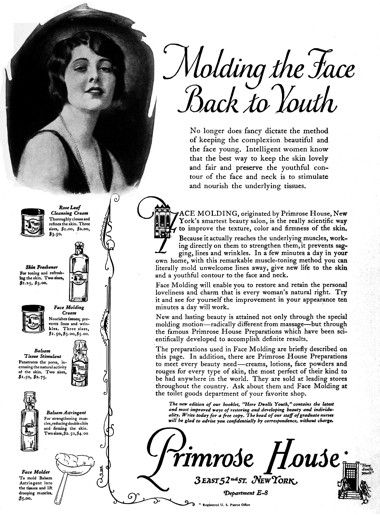
1924 The Primrose House Face Molding Treatment Set consisted of Rose Leaf Cleansing Cream; Skin Freshener; Face Molding Cream; Balsam Tissue Stimulant; Balsam Astringent; and Face Molder.
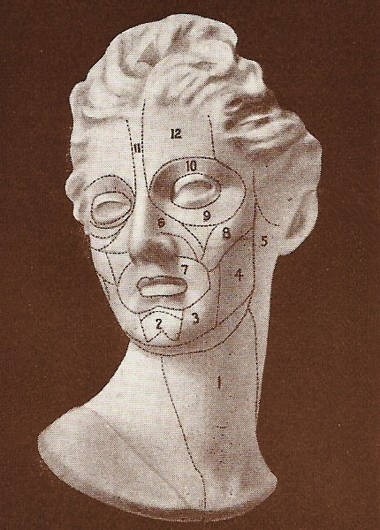
Primrose House chart showing the muscle lines to be followed during moulding emphasising the idea of the face as sculptural form.
“Mold upward on the muscle indicated by 1, in order to banish wrinkles and flabbiness on the throat.
Mold upward on 2, 3, 4 and 5, to relieve sagging and to restore the smooth round contour of the face. Number 4 is the important master muscle. Sagging cheeks soon follow when the master loses its elastic firmness.
Mold down on 6 for shaping the nose. Mold up and around 7 towards the mouth corners, to contract the droop of the lips.
Mold upward and outward on 8, the heavy muscle across the cheek. Mold gently outward on 9 to eradicate crow’s feet and tiny lines around the eyes. Mold upward and outward on 10 to firm the muscle above the eye. Mold up on 11 and 12.
If there are any deep wrinkles, shrunken cheeks and hollows apply Balsam Tissue Stimulant along the lines of the face, over the Face Molding Cream, and mold the shrunken muscles with this rich tissue builder.” (Primrose House, n.d., pp. 6-8).
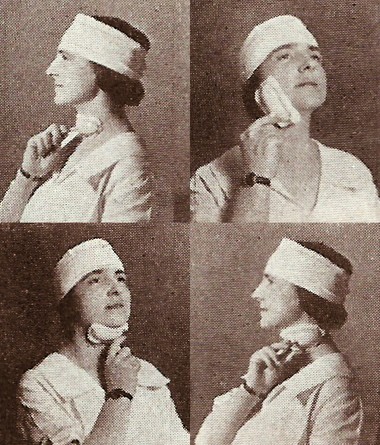
Primrose House Face Molder as developed by Lucille Buhl Bonanno.
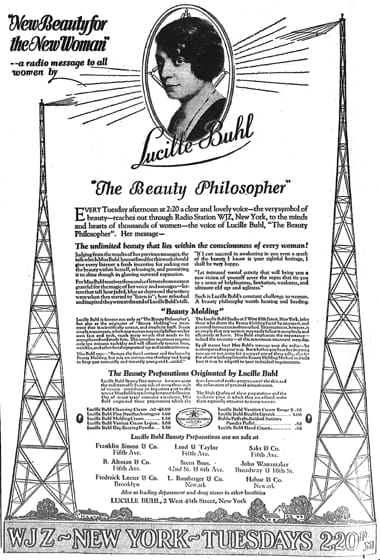
1928 Lucille Buhl Cosmetics. After Lucille left Primrose House, she opened her own cosmetic business. Lucille promoted her Buhl Beauty Preparations and ‘Beauty Molding’ through print and radio advertising.

Contouré Laboratories face molding movements.
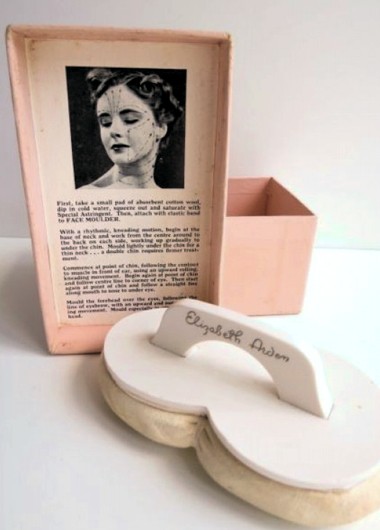
Elizabeth Arden’s Ardena Face Moulder.

1937 Elizabeth Arden Face Moulding Home Treatment with Ardena Velva Cream, Venetian Cleansing Cream and Ardena Skin Tonic.

1954 Elizabeth Arden Firmo-Lift Treatment to mould the face.
“It begins with cleanliness. Two thorough gentle massages with Ardena Cleansing Cream swept away with quantities of fresh tissues. Then: a pad of cotton wool dipped in cold water and steeped in Firmo-Lift Lotion, a formula carefully calculated to tighten and lift the skin. Press it against your face, stroke upward in deep, sweeping movements; you will feel a firm, lifting sensation. Last, smooth the scented Special Oil over any age-revealing lines; this leaves the skin silky.”
